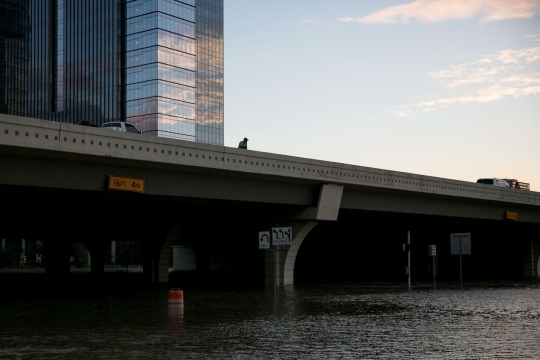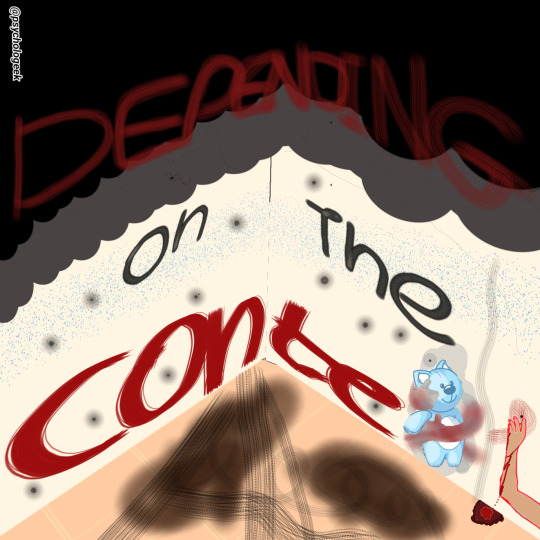#pennsylvania state university
Text

A bulldozer works to maintain Chicago's underground. More frequent and intense storms pose danger to aging infrastructure like these tunnels. Photograph By Keith Ladzinski, National Geographic Image Collection
Here’s What Worries Engineers The Most About U.S. Infrastructure
Water and sewer systems built in the mid-19th century weren't meant to handle the demands of modern cities, and many bridges and levees have aged well past their intended lifespan.
— By Alissa Greenberg | July 17, 2023
Christine Kirchhoff’s family were preparing to move into a new house when Hurricane Harvey hit Houston in 2017. Then the massive storm dumped 50 inches of rain on the area in just a few days, leaving two nearby reservoirs so full that their operators were forced to open the floodgates. Kirchhoff’s family had to be evacuated by boat. Both their original and new houses were inundated.
As an associate professor of civil and environmental engineering at Pennsylvania State University, Kirchhoff spent a lot of time thinking about water even before it swallowed her family’s livelihood. She is part of the legion of professionals behind the complex, often invisible systems that support American life: dams, roads, the electric grid, and much more.
For the last 25 years, the American Society of Civil Engineers has been sounding the alarm on the state of that infrastructure across the country. In their most recent assessment, for example, transit scored a D- and hazardous waste a D+. It’s an expensive problem to ignore. The ASCE estimates current infrastructure conditions cost the average family $3,300 a year. “Everyone is paying whether they know it or not,” Kirchhoff says.
Train derailments, highway and bridge collapses, and dam failures have become increasingly common. But which areas are civil engineers most concerned could cause imminent catastrophe, and what can we do about it? Kirchhoff and other infrastructure experts weigh in.
Water Contamination Crises are Already Here
The engineers we talked to agreed: our water systems are in trouble. Both those that protect us from water as a hazard (stormwater, dams, levees, bridges) and those that help us manage water as a resource (drinking water, wastewater, inland waterways) are in grim shape.

Streets were flooded after Hurricane Harvey hit Houston in 2017. Photograph By Ilana Pancih-Linsmam, The New York Times/Redux
The United States’ 2.2-million-mile drinking water and 800,000-mile sewer system was developed in part in response to the widespread waterborne diseases of the mid nineteenth century, Kirchhoff says. Maintenance has lagged woefully behind since then; some older areas, including some cities in the northeast, still use century-old wooden pipes. And many more of our pipes nationwide are still made of lead.
A water system designed for yesterday’s climate and to filter yesterday’s contaminants is especially problematic in a world of increasing demand, fiercer and more frequent storms, and “forever” chemicals. The result: boil orders, water main breaks, and sewer overflow, plus 15 percent of our water treatment plants working at or over capacity. These issues, combined with the toxicity of lead pipes, lead to water crises like the one that continues to plague Flint, Michigan.
Amlan Mukherjee, the director of sustainability focusing on infrastructure at WAP Sustainability Consulting, recommends focusing on these pipes—swapping lead for PVC or other materials and fixing the leaks that spill some 6 billion gallons of treated water a day—as one high priority fix.
Our coastline is also dotted with facilities storing hazardous oil and other chemical waste cocooned in donut-shaped earthen structures, adds Bilal Ayyub, a professor of civil and environmental engineering at the University of Maryland at College Park—structures that, he notes, could be made of concrete. Because of soil’s vulnerabilities, he worries that dramatic rainfall or a storm surge could destroy these structures, resulting in a release of toxic chemicals “bigger than the Exxon Valdez spill by orders of magnitude.”
His worst-case scenario has already happened at least once, when floodwaters from Hurricane Harvey ate through the earthen container at the San Jacinto River Waste Pits, releasing noxious waste into a nearby river.
Physical Collapse is Happening Now
Meanwhile, the number of high-hazard-potential dams in the United States now tops 15,000. Many were built during or before the WWII era and have been widely neglected since then. And when it comes to bridges, “there are cautionary tales all over,” says Maria Lehman, president of ASCE and vice chair of the Biden Administration’s National Infrastructure Advisory Council. “Every county in the country has a list of bridges that, if they had money, they would replace tomorrow.”
Our 617,000 bridges include not just those spanning mighty rivers but also every highway overpass and minor link across a stream—and close to one tenth of them are significantly compromised. “If you have to think in terms of catastrophe, we’re already there,” Mukherjee says. In 2007, the collapse of an I-35W bridge in Minnesota killed 13 people and injured 145. More recently, a six-lane bridge over the Mississippi was closed for three months in 2021, disrupting interstate travel and shipping because an inspector missed a significant crack. Americans drive 178 million trips on structurally deficient bridges each day.

Every day, millions of Americans travel across bridges and overpasses, like the Marquette Interchange in Milwaukee, that may be structurally deficient. Photograph By Keith Ladzinski, National Geographic Image Collection
Yet the US spends only 1.5-2.5 percent of its GDP on infrastructure, proportionately less than half of what the European Union spends, Lehman says. This long-term lack of funding has run out the clock on many solutions. Many of our bridges were built to last 30-50 years, but nearly half are at least half a century old. The average age of our levees is also 50; our dams average 57.
Now, extreme weather is intensifying just as structures fail. We’ve already seen consequences in the devastation of Hurricane Katrina in 2005, for example, when collapsing levees inundated 80 percent of New Orleans, killing hundreds, or in the failure of an under-inspected dam in Edenville, Michigan, which flooded the region and destroyed thousands of homes in 2020. The trend is set to continue: after Superstorm Sandy engulfed New York City transit, Ayyub helped study similar risks in Washington, D.C and Shanghai. His models showed widespread flooding that could swamp D.C. metro stations and in severe cases even reach “the backyard of the White House.”
The Future of U.S. Infrastructure
Mukherjee is optimistic about the use of new technology to solve some of these issues, though adoption has been slow. Drones can provide human inspectors with up-close views of areas they can’t reach themselves and reduce chance of human error; a drone on an unrelated project captured footage of the Mississippi bridge crack two years before its discovery.
Ayyub has also worked with North American freight railroads to find weak links using computer modeling, combing through thousands of stations to “identify exactly which point if it fails will have the biggest impact,” he says. Why not do the same with our power grid and waterways?
One piece of good news: in 2021, Congress passed the Bipartisan Infrastructure Law, which provides $1.2 trillion over five years for the ailing systems that help American society run, the largest federal investment in US history. It was a major victory. “Every president for the last eight presidents said we should spend a lot of money—like a trillion dollars—on infrastructure, and none of them delivered,” Lehman says.
Unless it is renewed regularly, though, this funding will barely stop the bleeding. And meanwhile, across the country, families like Kirchhoff’s (who after a difficult year were able to rebuild both the destroyed houses) struggle to recover from a relentless march of disasters, many of them preventable. It’s time for the US to learn the lessons drawn from of a century of neglect, Lehman argues, and begin maintaining the systems that makes so much of American life possible while they’re still in working condition.
“If you have a leak in your roof, you go up there, find it, replace the shingles, put on a little tar” she says. “If you let it go, it’s not going to be a little fix: it’s going to be a replacement.”
#US 🇺🇸#Infrastructure#Alissa Greenberg#Engineers#Christine Kirchhoff#Environmental Engineering#Pennsylvania State University#American Society of Civil Engineers#Contamination#Bilal Ayyub#University of Maryland#Amlan Mukherjee#Exxon Valdez#Hurricane Harvey#Biden Administration’s National Infrastructure Advisory Council#Mississippi River#European Union 🇪🇺#Hurricane Katrina#New Orleans#Superstorm Sandy#New York City#Washington D.C.#White House#Infrastructure Law
2 notes
·
View notes
Link
#Bocaítos#Puerto Rico#Amílcar Matos-Moreno#Contextomy#National Institute on Aging#Pennsylvania State University#Social Science Research Institute’s Population Research Institute at Penn State
0 notes
Text
Mia Vesely | I dropped sorority rush and I’m glad | The Daily Pennsylvanian
0 notes
Text
Robert and the pills
So I had an interesting MAX ride yesterday. On the way to work a guy board at PGE Park. He seemed unstable and became agitated when lady tried to help him get seated in the handicap section. The guy asked me to help him with his bag (his speech was really slurred). The guy said that he needed an ambulance. I freaked out at first but ask the guy his name. The man, Robert, did as well as his cell…
View On WordPress
#Ambulance#Emergency medical technician#Navy#Paramedic#Penn State#Pennsylvania State University#Question#Robert
0 notes
Text
Themis Matsoukas biography: 10 things about ex-Penn State professor
Themis Matsoukas is a former professor from Pennsylvania, United States. Here are 10 more things about him:
youtube
View On WordPress
0 notes
Text
Julio Urbina, de niño lavaba carros, hoy es profesor de la Universidad Estatal de Pennsylvania: mi vida ha sido como una escalera (con muchos peldaños)
Julio Urbina, de niño lavaba carros, hoy es profesor de la Universidad Estatal de Pennsylvania: mi vida ha sido como una escalera (con muchos peldaños)
Vivía en un callejón de Barranco y su amor por la ciencia lo ha convertido en un profesional de éxito internacional. Para los jóvenes que piensan en su futuro, les presentamos esta entrevista.
Modesto Montoya: ¿Todavía existe el callejón de viviste en tu niñez?
Julio Urbina: Claro, obviamente, todavía existe el callejón. En la calle Dávalos 250 Interior 5 Barranco. Ese es mi callejón, allí…

View On WordPress
0 notes
Text
Vimalakirti Sutra
One of the great Buddhist texts. The Vimalakirti Sutra http://wp.me/pFy3u-2bx
Images of scroll from The Metropolitan Museum of Art.
Northern Song dynasty (960–1127)
Gold and silver on purple silk
11 in. × 26 ft. 7/8 in. (27.9 × 794.7
Throughout Buddhism’s early history in China, the ascetic aspects of the religion—the practice of celibacy and asceticism — came into conflict with the Chinese family system and social values. The Vimalakirti Sutra, celebrating the supremely…

View On WordPress
#Buddhist blog#Buddhist teaching#Chinese Buddhism#Licchavi#Metropolitan Museum of Art#Northern Song dynasty#Pennsylvania State University#Robert Thurman#Vaisali#Vimalakirti Nirdesa Sutra
1 note
·
View note
Text
"Is murder okay?"

Psychologeek, digital art. 2023.
Drawing, because I don't have words.
#art#my art#digital art#depending on the context#harvard#Pennsylvania#pen u#mit#penn state university#un women#liz magill#elizabeth magill#university of pennsylvania#claudine gay# Sally Kornbluth#Massachusetts Institute of Technology#House Education and Workforce Committee#jumblr#ישראבלר
26 notes
·
View notes
Text

Title/Name: Donald John Trump, popularly known as 'Donald Trump' or simply ‘Trump’, born in (1946).
Bio: American politician, president of the United States, media personality, and businessman.
Country: USA
Wojak Series: Soyjak (Variant)
Image by: Unknown
Main Tag: Trump Wojak
#Wojak#Donald John Trump#Donald Trump#Trump#Trump Wojak#Soyjak#Soyjak Wojak#American#politician#Politics#businessman#economics#University of Pennsylvania#USA#President#president of the United States#Soyjak Series#Yellow#Orange#Purple
4 notes
·
View notes
Text

I forgot to show y'all what we picked up last weekend at a yard sale. He's so handsome!
32 notes
·
View notes
Text
Man arrested over University of Idaho killings
Man arrested over University of Idaho killings

View On WordPress
#America#crime#meme#memes#murder#news#pennsylvania#stabbing#united states#University of Idaho#Washington State University
3 notes
·
View notes
Text
Colleges Near Pittsburgh
Discovering the Colleges and Universities in Pittsburgh
Pittsburgh has a vibrant collegiate landscape with many colleges and universities that provide quality education and a variety of opportunities to students. From Carnegie Mellon University to the University of Pittsburgh, the city has the perfect mix of private and public institutions. In this article, we will explore the colleges and…

View On WordPress
#Catholic Colleges Near Pittsburgh#Christian Colleges Near Pittsburgh Pa#Colleges And Universities Near Pittsburgh Pa#Colleges Around Pittsburgh Area#Colleges Around Pittsburgh Pa#Colleges Close To Pittsburgh#Colleges Close To Pittsburgh Pa#Colleges In Near Pittsburgh Pa#Colleges In Pennsylvania Near Pittsburgh#Colleges Near Pittsburgh#Colleges Near Pittsburgh Pa#Colleges Near Pittsburgh Pennsylvania#Colleges Near University Of Pittsburgh#Community Colleges Near Pittsburgh#Private Colleges Near Pittsburgh Pa#Public Colleges Near Pittsburgh Pa#Small Colleges Near Pittsburgh#State Colleges Near Pittsburgh#Top Colleges Near Pittsburgh Pa#What Colleges Are Near Pittsburgh
2 notes
·
View notes
Text
youtube
penn state sorority rush 2023!
Published by megan vu
#Pennsylvania State University#PSU#penn state#Sigma Sigma Sigma#Tri Sigma#trisigmapsu#Beta Upsilon Chapter#ΣΣΣ#Youtube
1 note
·
View note
Text
What Penn State professor Themis Matsoukas did to his pet collie
Themis Matsoukas, 64, of State College, Centre County, Pennsylvania, United States is a professor at Pennsylvania State University (Penn State) in University Park, State College. He has been teaching chemical engineering there since 1991.
youtube
View On WordPress
0 notes